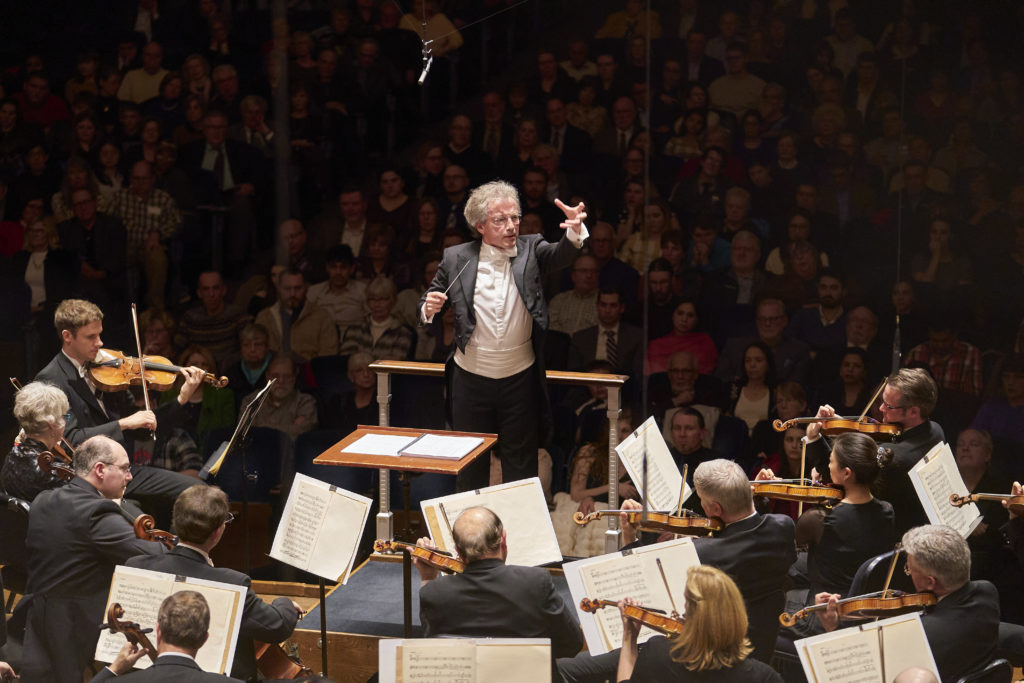There’s probably nothing more jarring than the brrrrrring of a cellphone call at a particularly dramatic moment in the movie, a vulnerable juncture in a speech — or during the cadenza in a violin concerto. The last happened, alas, to Lisa Batiashvili Sunday during the first movement of the Tchaikovsky Violin Concerto with The Cleveland Orchestra, just as Batiashvili was working her talented way into its stratospheric measures. As painful as it was for the Artis—Naples audience, that was the only moment of dismay in a program that reminded us that Cleveland is still diamond-strong and equally sparkling.
Conductor/Music Director Franz Welzer-Möst veritably welded the orchestra to Batiashvili, pulling it far back behind her legato-rich opening, but ready to leap when the orchestra was called on for its own statements. Even those of us who feel they’ve heard this Tchaikovsky beyond surprises were impressed by the intense, infectious performance. Batiashvili coaxes luscious sound from her Guarneri, rich and full. She appreciated her partnership with orchestra as well, beaming through the final movement with them, and the musicians did the same through three standing ovations.
There was no breathing space after intermission. And the orchestra was already working with figurative sweat on the floor. On Thursday and Friday, the Naples Philharmonic had been there, producing an amazing multitempo rendition of Gabriela Montero’s high-energy Latin Concerto and keeping up admirably with guest conductor Alexander Shelley’s frankly rushed approach to the Beethoven Symphony No. 5.
For Cleveland, the first of two second-half challenges was contemporary composer Bernd Richard Deutsch’s “Intensity” (2019), written specifically for the orchestra. It orbits three segments through repeating phrases that build its sense of urgency, and carries along an array of percussion instruments as unusual as slidewhistles and rainsticks. Its second segment operates like a slow glide through the obstacle course of a Kandinsky painting. The horns send out ominous motifs; the strings take on a slightly woozy theme. But quickly there’s a resurgence of wind-fed drama, increasing in tempo and ramped up with drive-by motifs of strings and a gong. Appropriately named, and engagingly performed.
The orchestra moved straight from that into Respighi’s “Roman Festivals,” a work that tips the scale at huge. It brought out nine double basses and more strings — and this is not an orchestra that lacks for them. One writer described this as “orgiastic,” and the instrumentation gives a hint to how apt that was. Along with the full orchestra, it made use of the Hayes Hall Casavant Frères pipe organ, a piano and enough percussion to fill a classroom: timpani, bells, glockenspiel, cymbals, bass drum with cymbals, field drum, snare drum, ratchet, sleigh bells, tambourine, tam-tam, triangle, wood blocks — at two different timbres — and xylophone.
But, after all, we’re talking about the Roman empire here.
Welzer-Möst was in the thick of it; he seems to truly relish creating the big masterpieces The Cleveland Orchestra can handle as few others can. The finish was cathartic, and the audience tried begging them back for an encore with several more standing ovations.
We are already excited for next year’s program.





